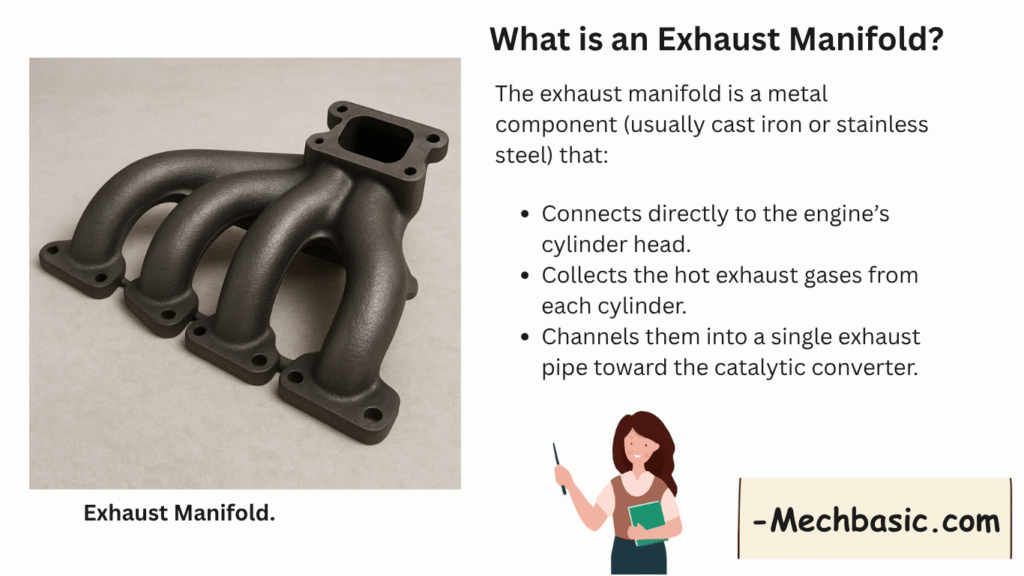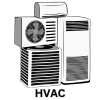The exhaust manifold is a key component in your vehicle’s exhaust system. It’s the first part of the exhaust system that handles exhaust gases right after they exit the engine’s cylinders. Here’s a detailed explanation of how it works:

In this article:
What is an Exhaust Manifold?
The exhaust manifold is a metal component (usually cast iron or stainless steel) that:
- Connects directly to the engine’s cylinder head.
- Collects the hot exhaust gases from each cylinder.
- Channels them into a single exhaust pipe toward the catalytic converter.
Common Materials Used for Exhaust Manifolds:
Exhaust manifolds are typically made from:
- Cast Iron – Durable, heat-resistant, and cost-effective; common in stock vehicles.
- Stainless Steel – Lightweight, corrosion-resistant, and better for performance; used in aftermarket or high-performance cars.
- Mild Steel – Cheaper than stainless, but less durable and prone to rust without coating.
Each material balances cost, heat resistance, and performance needs.
- Cast Iron: Durable and heat-resistant, commonly used in regular cars.
- Stainless Steel: Lighter, better for high-performance or turbocharged engines.
Working of an Exhaust Manifold( step by step):
1. Combustion Produces Exhaust Gases
- Inside each engine cylinder, fuel and air are burned during combustion.
- This produces high-pressure, high-temperature exhaust gases (mainly CO₂, H₂O, NOx, HC, and CO).
2. Gases Exit Through Exhaust Valves
- Each cylinder has one or more exhaust valves.
- As the piston moves upward in the exhaust stroke, these valves open, and exhaust gases are pushed out into the exhaust ports on the cylinder head.
3. Exhaust Manifold Collects Gases
- The exhaust manifold is bolted to the cylinder head and covers the exhaust ports.
- It collects the gases from all cylinders and channels them into a common passage.
Example: In a 4-cylinder engine, the manifold has 4 inlets and 1 outlet.
4. Merges and Directs Gases into Downpipe
- The design of the manifold merges these gases smoothly to minimize turbulence.
- Gases then flow into the downpipe, then to the catalytic converter.
Thermal Role:
- It must handle extreme heat: up to 1200°F (650°C) or more.
- Heat shields or insulating wraps are often added to protect surrounding components.
Purpose and Importance
| Function | Benefit |
|---|---|
| Collects exhaust gases | Enables clean removal from engine |
| Prevents gas backflow | Maintains engine efficiency |
| Directs gas flow | Ensures smooth flow to catalytic converter |
| Helps with engine timing and tuning | Especially in performance or turbo setups |
Exhaust Manifold vs. Header (Performance Note)
- Exhaust Manifold: Prioritizes durability and cost (cast iron, simpler flow).
- Headers: High-performance alternative; use individual tubes for each cylinder to optimize exhaust scavenging and reduce backpressure.
Signs of a Bad or Leaking Exhaust Manifold
- Tapping or ticking noise (especially at startup)
- Poor engine performance
- Decreased fuel efficiency
- Burning smell from under the hood
- Check engine light
Summary
| Component | Role |
|---|---|
| Cylinder head | Sends exhaust gases into manifold |
| Exhaust manifold | Collects gases and sends to catalytic converter |
| Downpipe | Connects manifold to rest of exhaust system |
FAQ Section:
1. What is an exhaust manifold?
An exhaust manifold collects exhaust gases from the engine’s cylinders and directs them into the exhaust pipe.
2. What materials are exhaust manifolds made of?
They are commonly made from cast iron, stainless steel, or mild steel—each offering different levels of durability, heat resistance, and cost.
3. What are the signs of a bad exhaust manifold?
Typical signs include ticking or tapping noises, decreased engine performance, a burning smell, or exhaust fumes inside the cabin.
4. What causes an exhaust manifold to crack?
Cracks usually result from repeated heating and cooling cycles, vibration, or poor-quality materials that can’t handle extreme temperatures.
5. Can a cracked exhaust manifold be repaired?
Some cracks can be welded, but replacement is often more reliable, especially if the manifold is severely damaged or warped.
6. How much does it cost to replace an exhaust manifold?
Replacement costs range from $300 to $1,000 or more, depending on your vehicle type, labor rates, and parts involved.
7. What’s the difference between an exhaust manifold and headers?
An exhaust manifold is a stock component made for durability and quiet operation, while headers are aftermarket parts designed for better performance and airflow.
8. Can a bad exhaust manifold affect fuel economy?
Yes, a leaking or cracked manifold can cause incorrect sensor readings, leading to an imbalanced air-fuel mixture and reduced fuel efficiency.
9. Is it safe to drive with a leaking exhaust manifold?
Not really. Leaks can lead to engine damage, reduced performance, and potentially harmful exhaust fumes entering the cabin.
10. How long do exhaust manifolds last?
They can last over 100,000 miles, but lifespan depends on driving conditions, maintenance, and the material of the manifold.
Other courses:



